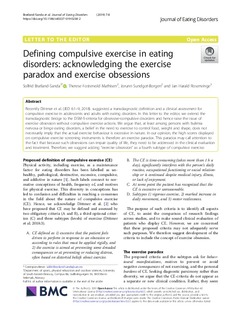Defining compulsive exercise in eatingdisorders: acknowledging the exerciseparadox and exercise obsessions
Journal article, Peer reviewed
Published version
Permanent lenke
http://hdl.handle.net/11250/2607285Utgivelsesdato
2019Metadata
Vis full innførselSamlinger
Sammendrag
Recently Dittmer et al. (JED 6:1–9, 2018). suggested a transdiagnostic definition and a clinical assessment for compulsive exercise in adolescents and adults with eating disorders. In this letter to the editor, we extend the transdiagnostic bridge to the DSM-5-criteria for obsessive-compulsive disorders and hence raise the issue of exercise obsession without compulsive exercise actions. We argue that, at least among persons with bulimia nervosa or binge eating disorders, a belief in the need to exercise to control food, weight and shape, does not necessarily imply that the actual exercise behaviour is excessive in nature. In our opinion, the high scores displayed on compulsive exercise screening instruments is therefore an exercise paradox. This paradox may call attention to the fact that because such obsessions can impair quality of life, they need to be addressed in the clinical evaluation and treatment. Therefore, we suggest adding “exercise obsession” as a fourth subtype of compulsive exercise.
Beskrivelse
Open Access This article is distributed under the terms of the Creative Commons Attribution 4.0 International License, which permits unrestricted use, distribution, and reproduction in any medium, provided you give appropriate credit to the original author(s) and the source, provide a link to the Creative Commons license, and indicate if changes were made. The Creative Commons Public Domain Dedication waiver applies to the data made available in this article, unless otherwise stated.

